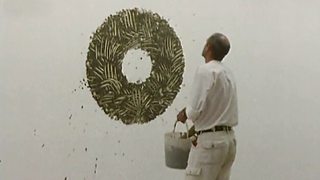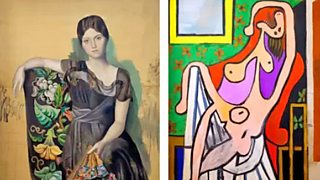I walk the line: How Richard Long turns epic journeys into art
10 May 2018
Land artist Richard Long is famous for his walks which challenge conventional notions of what art ought to be. Ahead of his Circle to Circle exhibition WIILLIAM COOK meets the artist who once walked 240 miles in eight days looking for places for sculptures.

In London’s Lisson Gallery, Richard Long is installing his latest show, Circle to Circle. Gaunt and sinuous, with the wild eyes and weather-beaten face of an Old Testament prophet, he looks more like an explorer than an artist – a yachtsman or a mountaineer. This is no surprise, for Long is unlike any other artist. His timeless artworks are byproducts of his epic journeys – journeys which challenge conventional notions of what art ought to be.
I can walk in a circle for one hundred miles.Richard Long
Circles have always been central to Long’s elemental work. "I can make a circle of words, I can make a circle of stones, I can make a circle of mud with my hands on a wall, I can walk in a circle for one hundred miles," he said, thirty years ago.
It’s not a bad summary of his career. He’s making a stone circle here, and a mud circle, but his seminal artworks are his mammoth walks, which often leave no record save for a line of text on a gallery wall. "From circle to circle, from space to earth, a continuous walk of 39 miles from a full moonrise to the sunrise," reads the writing on this wall.

Painting with mud
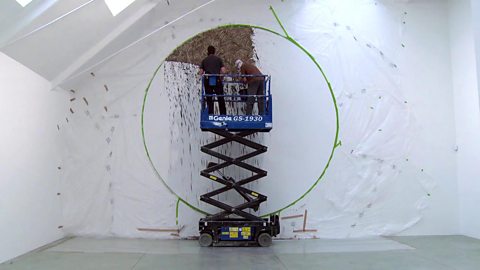
Richard Long prepares for his exhibition Circle to Circle at Lisson Gallery
The English artist creates a crescent mud work directly onto the gallery wall.
Richard Long was born in 1945, in Bristol. He was artistic from an early age ("I was always painting and drawing") but his early wanderings were just as formative – up on the Downs, above the city, and along the River Avon.
That was the biggest break I had in my whole life, getting thrown out of Bristol.Richard Long
"That was my childhood playground," he says. "It was a great place to grow up." He loved making mud pies as a toddler. He still works with mud today. He still lives in Bristol. The Downs and the Avon are still pivotal.
He’s been to Alaska and Antarctica, to the Andes and the Himalayas, but his adventures can just as easily begin outside his front door. "My work operates on all different scales, from a fingerprint to a thousand miles."

Long went to art school in Bristol but, incredibly, he was kicked out.
"I loved art school – in the second year I got the painting prize and in the third year they threw me out," he says, cheerfully. "I was very shocked that I was thrown out, because it came out of the blue. I was very precocious – maybe I was being too precocious."
Yet it turned out to be the making of him. "That was the biggest break I had in my whole life, getting thrown out of Bristol, because it meant I went to London," he says.
He went to St Martin’s School of Art, where he enrolled on the groundbreaking sculpture course led by the innovative art teacher Frank Martin.
"He had an amazing nose for art." Students were free to do whatever they wanted. It was the perfect place for Long to thrive. On his first day, he met George Passmore, soon to become one half of Gilbert & George. "It was like going to school with Oscar Wilde," he recalls.
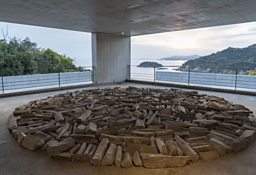
A work he made at art school, A Line Made by Walking, sums up his attitude to art, and nature. It’s exactly as it sounds. He found a meadow and walked up and down, in a straight line, and took a photograph of the faint line he’d left behind.
The photo wasn’t the artwork. Nor was the line he’d made, which wouldn’t last. The artwork was the walking.
It was a good photo but it wasn’t a great photo. The photo wasn’t the artwork. Nor was the line he’d made, which wouldn’t last. The artwork was the walking. This was a landmark in conceptual art.
"I’m not there just to take photographs," he explains. "I like to move stones around, carry stones in my pocket, make circles, make lines..."
Within a year of leaving college, Long had solo shows in Paris, Milan, New York and Düsseldorf ("I had to leave England to find the art world that was interested in my work"). Since then he’s had one man shows in the world’s greatest galleries (the Pompidou, the Guggenheim, MoMA, The Tate…) but his work is so pure and simple, neither money nor fame can spoil it.
He’s been doing the same thing for fifty years – making lines by walking, leaving a few traces along the way. He speaks to the child in all of us, collecting shells and pebbles, building sandcastles on the beach.
His art doesn’t try to dominate the landscape. It’s not weighed down by pride or vanity. "There’s lots of works that you don’t know about because I haven’t chosen to show you," he laughs. "In all my work you’re just seeing the tip of the iceberg."
Some of his sculptures are in such remote places that nobody will ever see them. A lot of his other sculptures will simply fade away. "If I’m on a walk that’s taken me near an old work I might go and check it out. Quite often, they’ve completely disappeared."

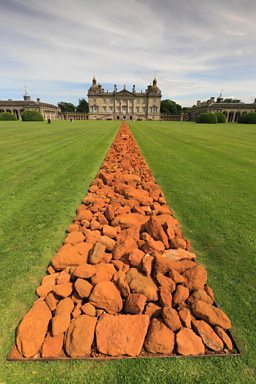
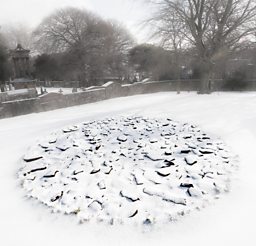
And after all these years, his passion for walking remains. "It takes me into beautiful landscapes, it takes me into fantastic wildernesses, it gives me freedom, independence." A few years ago he walked 240 miles in eight days, from Cornwall to Oxfordshire (pretty good going for an OAP) but it’s not an endurance test – it’s about finding places to make sculpture in. "Whatever the place, the place comes first, and it tells me what I should do."
What if he went to these places by helicopter? "It wouldn’t be the same. It’s important that I find the places I make my sculptures in by walking. I’m embedded in the landscape by walking through it. They’re stopping places on the journey, and the journey is by walking. I don’t foresee the places where I’m going to make sculptures. I come across them by chance."
His work seems avant-garde, but it has far more in common with the atavistic art of so-called primitive societies – the religious monuments of nomads and hunter-gatherers. There’s a powerful element of ritual and pilgrimage in his art.
"Walking is embedded in the whole of human history – people walked out of Africa on foot to colonise the world," he says. "I’m just putting something new on all the other traditions of walking that have happened before."
Circle to Circle is at the Lisson Gallery, London from 11 May to 23 June 2018.
More on Richard Long
-
![]()
Sculpture at Houghton Hall
The artist's journeys on foot around the world served as inspiration for the abstract sculptures.
-
![]()
A Line Made by Walking
Richard Long discusses his original piece of land art, made in a meadow outside London.
-
![]()
Richard Long on Omnibus
Richard Baker introduces a short film celebrating Richard Long, showing him at work on Dartmoor.
More from BBC Arts
-
![]()
Picasso’s ex-factor
Who are the six women who shaped his life and work?
-
![]()
Quiz: Picasso or pixel?
Can you separate the AI fakes from genuine paintings by Pablo Picasso?
-
![]()
Frida: Fiery, fierce and passionate
The extraordinary life of Mexican artist Frida Kahlo, in her own words
-
![]()
Proms 2023: The best bits
From Yuja Wang to Northern Soul, handpicked stand-out moments from this year's Proms


